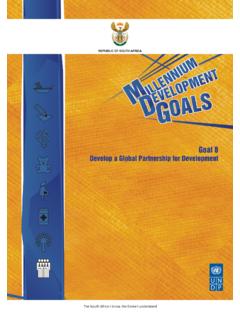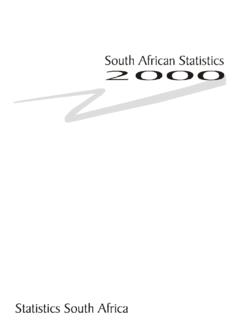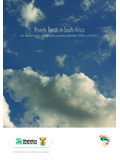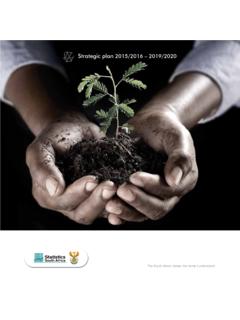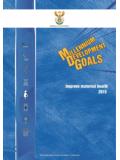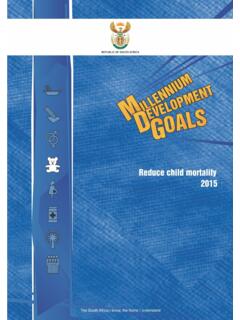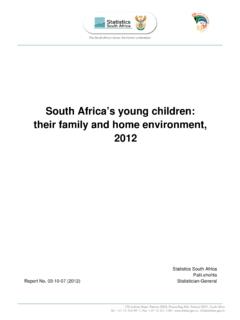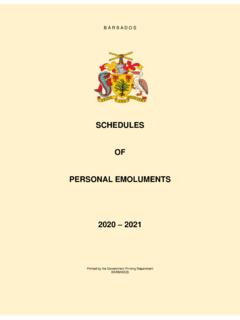Transcription of Profile of persons with disabilities in South Africa
1 Profile of persons with disabilities in South AfricaThe South Africa I know, the home I understand Census 2011: Profile of persons with disabilities in South Africa Statistics South AfricaPali LehohlaStatistician-GeneralReport No. 03-01-59 Statistics South Africa Census 2011: Profile of persons with disabilities in South Africa iCensus 2011: Profile of persons with disabilities in South Africa / Statistics South Africa Published by Statistics South Africa , Private Bag X44, Pretoria 0001 Statistics South Africa , 2014 Users may apply or process this data, provided Statistics South Africa (Stats SA) is acknowledged as the original source of the data; that it is specified that the application and/or analysis is the result of the user's independent processing of the data.
2 And that neither the basic data nor any reprocessed version or application thereof may be sold or offered for sale in any form whatsoever without prior permission from Stats SA. Stats SA Library Cataloguing-in-Publication (CIP) Data Census 2011: Profile of persons with disabilities in South Africa / Statistics South Africa . Pretoria: Statistics South Africa , 2014 Report 03-01-59 210 pp ISBN 978-0-621-42793-6 A complete set of Stats SA publications is available at Stats SA Library and the following libraries: National Library of South Africa , Pretoria Division National Library of South Africa , Cape town Division Library of Parliament, Cape town Bloemfontein Public Library Natal Society Library, Pietermaritzburg Johannesburg Public Library Eastern Cape Library Services, King William s town Central Regional Library, Polokwane Central Reference Library, Nelspruit Central Reference Collection, Kimberley Central Reference Library, Mmabatho This publication is available on the Stats SA website: For technical enquiries please contact: Rika du Plessis Tel: 012 3108035 Email.
3 For dissemination enquiries please contact Printing and Distribution, Statistics South Africa Tel: (012) 310 8619 (012) 310 8093 Email: Statistics South Africa Census 2011: Profile of persons with disabilities in South Africa , Report 03-01-59 ii Statistics South Africa Census 2011: Profile of persons with disabilities in South Africa , Report 03-01-59 iiiPreface Evidence-based decision-making has become an indispensable practice universally because of its role in ensuring efficient management of population, economic and social affairs.
4 It is in this regard that Statistics South Africa (Stats SA) is mandated to provide the state and other stakeholders with official statistics on the demographic, economic and social situation of the country to support planning , monitoring and evaluation of the implementation of programmes and other initiatives. In fulfilling its mandate prescribed in the Statistics Act (Act No. 6 of 1999), Stats SA has conducted three censuses (1996, 2001 and 2011) and various household-based surveys. Censuses remain one of the key data sources that provide government planners, policymakers and administrators with information on which to base their social and economic development plans and programmes at all levels of geography.
5 Census information is also used in monitoring of national priorities and their achievement, and the universally adopted Millennium Development Goals (MDGs). This demand for evidence-based policymaking continues to create new pressures for the organisation to go beyond statistical releases that Profile basic information and to embark on the production of in-depth analytical reports that reveal unique challenges and opportunities that the citizenry have at all levels of geography. This analytical work also enhances intellectual debates that are critical for policy review and interventions.
6 The above process is aimed at enabling the organisation to respond to and support evidence-based policymaking adequately, build analytical capacity and identify emerging population, socio-economic and social issues that require attention in terms of policy formulation and research. The monograph series represents the first phase of detailed analytical reports that are theme based and that address topics of education, disability, ageing, nuptiality, age structure, migration, fertility, and mortality, among others. The disability monograph provides a comprehensive Profile of persons with disabilities in South Africa , exploring key aspects pertaining to their demographics, socio-economic status as well as their health status in terms of functioning.
7 The differentials and spatial distributions by sex, population group and geographical location profiled bring forth critical issues pertaining to the well-being of this vulnerable group. PJ Lehohla Statistician-General Statistics South Africa Census 2011.
8 Profile of persons with disabilities in South Africa , Report 03-01-59 ivAcknowledgements Statistics South Africa would like to thank the following contributors for their part in the compilation of this report: Angela Ngyende, Amos Moto, Margaret Africa , Leonard Ahuejere, Babalwa Fana, Dorothy Bokaba and Mmakwena Malapile. The organisation is grateful for the technical expertise provided by the following internal reviewers: Ni l Roux, Azam Khan, Dr John Kekovole, Dr Christine Khoza, Rika du Plessis, Dr Dan Kibuuka. Statistics South Africa also wishes to express its gratitude towards the following external reviewers: Dr Marguerite Schneider, Lidia Pretorius and Simmi Pillay.
9 Your expertise and inputs have added great value in improving the quality of this publication. Statistics South Africa Census 2011: Profile of persons with disabilities in South Africa , Report 03-01-59 vEXECUTIVE SUMMARY Mainstreaming disability in society has been well articulated at global, regional and national levels. It is widely recognised that such efforts can only be realised if statistics on disability prevalence, patterns and levels are availed at all levels of society. Disability statistics provide the basis for measuring progress in realising the rights of persons with disabilities .
10 In South Africa , current and future policies and interventions to ensure that persons with disabilities have equal access to education, employment and basic services require statistical evidence. This report provides statistical evidence relating to the prevalence of disability and characteristics of persons with disabilities at both individual and household levels, based on Census 2011 data. The results cannot be compared to the results of the previous censuses of 1996 and 2001 and the Community Survey of 2007, due to differences in the questions that were asked. The report also does not include statistics on children under the age of five or on persons with psychosocial and certain neurological disabilities due to data limitations, and should therefore not be used for purposes of describing the overall disability prevalence or Profile of persons with disabilities in South Africa .
